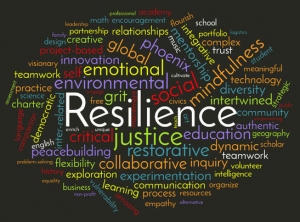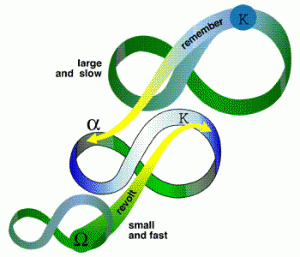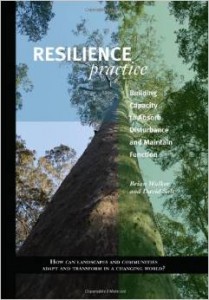About Resilience
 So what is resilience? The word resilience is now common in many vision and mission statements. But if you ask the people who use those statements what they think it means, you get a range of answers, most of which include something about how we cope with change or with a shock or a disturbance.
So what is resilience? The word resilience is now common in many vision and mission statements. But if you ask the people who use those statements what they think it means, you get a range of answers, most of which include something about how we cope with change or with a shock or a disturbance.
The concept of resilience is used by all sorts of disciplines. The word has four main origins – psycho-social, ecological, disaster relief and engineering. Psychologists recognize differences in the resilience of individuals confronted with traumatic and disastrous circumstances. Ecologists often describe resilience in two ways: one focused on the speed of recovery following a disturbance, the other on whether or the ecosystem can recover. There is lots of research on how individuals, ecosystems and societies gain and lose resilience. People looking at resilience from the disaster relief perspective incorporate both aspects – speed and ability to recover. So there’s lots of commonality in understanding resilience across psychology, ecology and disaster relief.
Engineers have a somewhat different take, associating “designed resilience” with robustness which assumes bounded uncertainty – they assume that the kinds and ranges of disturbances and shocks are known, and the system is designed to be robust in the face of these shocks. These different takes on resilience are described in more detail in Resilience Practice by Brian Walker & David Salt.
Like Walker and Salt, who also authored Resilience Thinking, we look at resilience as the capacity of an individual, community or system to absorb disturbance and reorganize in a way that the person or system retains essentially the same function, structure and feedbacks – has the same identity and is able to cope with shocks and keep functioning in a similar way. The word identity is useful because it reminds us that people, communities, societies, and social-ecological systems can exhibit quite a lot of variation, be disturbed and cope, without changing their “identity” – without becoming something else. Sometimes resilience is simply described as the ability to bounce back.
Resilience also has a lot to do with complexity, and more and more of the problems we face in today’s world are complex problems. Facilitator and Coach Chris Corrigan says that the difference between complex problems and complicated problems comes down to whether a problem is solvable or not. Is there a stable outcome? Is there an end state? Can research and expertise provide us with answers? Is the situation predictable? If the answer yes, you have a complicated problem. Answer no and you have a complex one. Building a community is complex; building a building is complicated.
Walker and Salt offer the following ten points (some technical language omitted) as fundamental to resilience thinking and resilience practice:
1. The systems we are dealing with are self-organizing, where order and coordination arise out of dynamic, non-linear local interactions and remain distributed and responsive to feedback – not based on a blueprint or master plan.
2. There are limits to a system’s self-organizing capacity.
3. These systems have linked social, economic and biophysical domains.
4. Self organizing systems move through adaptive cycles.
5. Linked adaptive cycles function across multiple scales.
6. Resilience has a number of dimensions.
7. Working with resilience involves both adapting and transforming.
8. Maintaining or building resilience comes at a cost.
9. Resilience is not about knowing everything.
10. Resilience is not about not changing.
So What Does This Mean for Nurturing More Resilient Individuals, Organizations, Communities, and Even a More Resilient World?
The first thing to remember is that resilience is anchored in relationships: personal, social, organizational and ecological. And relationships are complex. Some relationships we know and understand, or at least partially understand, and other relationships exist that we are unaware of until they are disturbed and we move into some kind of disequilibrium. Again, borrowing heavily from Walker and Salt, here are some basic principles and directions we can put into practice in nurturing resilience:
1. Promote and sustain diversity in all its forms – biological, social, economic, etc. Diversity means more options for responding to disturbances.
2. Embrace and work with ecological variability, rather than trying to control or reduce it, remembering nature moves in adaptive cycles e.g. a forest that is never allowed to burn loses its fire resistant species. This also applies to relationships within human communities.
3. Maintain or create a degree of modularity, where everything is not inextricably connected to everything else. Over-connected systems are vulnerable as they can rapidly transmit a shock through the whole system.
 4. Focus on slow variables and the different time scales within systems. These can be associated with crossing thresholds into different and potentially undesirable states, especially if we don’t attend to them. Climate change, which has fast and slow variables operating in different time scales is especially challenging for us to respond to effectively through human, linear systems of policy and governance that don’t incorporate a resilience perspective. This principle can also be applied to a community or a long-term personal relationship, complex dynamic systems on smaller scales.
4. Focus on slow variables and the different time scales within systems. These can be associated with crossing thresholds into different and potentially undesirable states, especially if we don’t attend to them. Climate change, which has fast and slow variables operating in different time scales is especially challenging for us to respond to effectively through human, linear systems of policy and governance that don’t incorporate a resilience perspective. This principle can also be applied to a community or a long-term personal relationship, complex dynamic systems on smaller scales.
5. Look for and encourage tight feedback loops that give timely signals of impending systems change. For example local and regional economies tend to have tighter feedback loops than the global economy.
6. Promote trust, connection, well-developed social networks and engaged, distributed leadership that embraces diversity. This is often referred to as social capital and can be more simply stated as “relationships matter”.
7. Emphasize learning, experimentation, locally adapted rules, and innovation, embracing change and responding to disturbance, not denying it. Think “What did we learn? What do we need to let go of in order to stay resilient?”
8. Consider redundancy in teams, institutions, governance and economies as an important part of increasing the response flexibility and diversity of a system. A focus on efficiency and centralization increases the risk of widespread systems failures – the “too big to fail” phenomenon. Diverse and “messy” structures, often local or regional ones rather than national or global ones, tend to perform better in times of change.
 9. Get to know our ecosystems, how they function, how we use them, who benefits and who doesn’t, how they can be affected by potential thresholds, and how changes in one can affect the resilience of others. Value all aspects of an ecosystem, not just those with economic benefit. This is often described as ecosystem services but it’s much more complicated than putting a monetary value of those “services”. Respecting and being curious about life in all its forms is another way to describe this principle, remembering it is all interconnected and there is no “away” where we can dispose of our waste.
9. Get to know our ecosystems, how they function, how we use them, who benefits and who doesn’t, how they can be affected by potential thresholds, and how changes in one can affect the resilience of others. Value all aspects of an ecosystem, not just those with economic benefit. This is often described as ecosystem services but it’s much more complicated than putting a monetary value of those “services”. Respecting and being curious about life in all its forms is another way to describe this principle, remembering it is all interconnected and there is no “away” where we can dispose of our waste.
10. Acknowledge the importance of fairness and equity. When everyone has a say, a sense of agency and the basics of life (clean water, nutritious food, shelter, safety), diversity, innovation, communication, collaboration, effective feedbacks and use of social capital are all encouraged.
Chris Corrigan also reminds us that, when dealing with complexity, it is important to be informed by our stories, myths and parables as these tend to translate across many contexts. Truth may more often be found in stories than in facts. We need to be constantly scanning for meaning through the system, rather than relying on a static vision.
Corrigan says, “In complexity, the future is already here, but it is quiet and hidden in the noise of the culture. In complicated systems the future is not here and it is well understood what it will take to get there from here. In complex systems, the solutions can come at you obliquely, out of the blue and in surprising ways, so you need to cultivate processes that allow that to happen.”
We can better understand our complex world and support increased personal and social-environmental resilience by looking at our world through a resilience lens. For many of us who are used to imagining that, with enough data, we can understand what is going on and influence the situation, this can be a big stretch. We are being asked to acknowledge the limits of our knowledge and our mastery, and our dependence on and inter-connectedness with the communities and ecosystems that support us.
There can be both fear and excitement here as we face the future and reflect on how much collaboration, adaptability and humility are essential to creating resilient lives, communities and a resilient world.